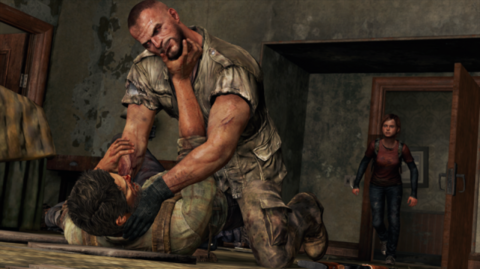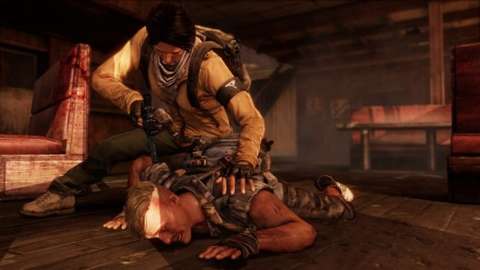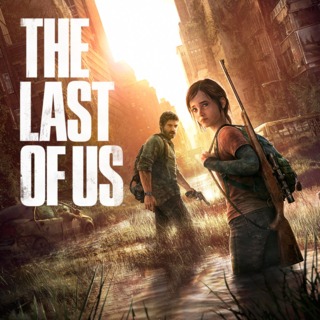As a console ventures deeper into its life-cycle, more high quality titles are to be expected. It goes without saying that the PS3 has accumulated a solid number of respectable exclusives, namely from the likes of Naughty Dog, who are responsible for the Uncharted series. Given the massive success of the Uncharted games, it almost came as a guarantee that their new, upcoming IP would turn out to be a huge success as well. Yet, this time around, Naughty Dog took a completely different approach with The Last of Us. Instead of an over-the-top, all-out fun action/adventure game comparable to Uncharted, The Last of Us is an incredibly gritty, emotional, and narrative-driven survival/action game. The Last of Us comfortably lives up to Naughty Dog’s reputation; Furthermore, it manages to exceed it by not only emerging as a game of the year contender, but a game of the generation contender as well.
Diving into it, The Last of Us revolves around a world devastated by a viral fungal infection, essentially turning people into zombie-like creatures that kill or infect remaining survivors. As worn out of a premise as that may seem, calling The Last of Us a generic zombie game is undoubtedly an insult. This is evident by the opening level, which actually provides an eye opening outlook on the world just before and as it’s all going downhill, which is appreciated as most apocalyptic games skip over such events. Aforementioned events are seen through the eyes of Joel, the main protagonist, who is a fairly typical man living a decent life as father before the whole outbreak occurred. The Last of Us wastes no time in tugging at your heartstrings after some unthinkable events unfold in the unforgettable intro. Thus, the dreary tone is set for what, unlike past Naughty Dogs game, is a brutal and emotionally draining game.
Jumping ahead 20 years later, the world is in a reasonably believable post-apocalyptic condition. The closest remnant to civilization resides within quarantined military zones, though punishments are almost certainly death to those who disobey. Then there’s Joel and his newly introduced partner Tess, who live life on the edge and smuggle weapons and do whatever else is necessary to survive in this new, inhospitable world. While this initial glance at this post-apocalyptic scene is interesting, the main plot doesn’t really unfold until you meet Ellie, a young teenage girl, who is genuinely the heart and soul of the story. The foremost task involving Ellie is simple- deliver her to the Fireflies, a group fighting against the other militia groups and attempting to find a cure for humanity.
Once Ellie is at Joel’s side, the game may appear to be one large escort mission. Fortunately, that is not the case. Ellie, along with other allies met along the way, are virtually never liabilities in any situation. Friendly AI isn’t perfect, though they rarely are a nuisance by getting in the way and can’t attract enemies to your position. The latter point may be one of extremely few minor criticisms to muster in The Last of Us as friendlies can be a bit noisy, yet not attract attention, thus possibly interfering with the immersion. Overall, however, this is a fair system since no one needs babysitting and there aren’t long, awkward sections without dialogue. Also, to be fair, Joel does remind Ellie to keep it down every once in a while. And as a plus, friendlies indubitably do provide significant help from time to time, occasionally going as far as supplying some much needed ammunition or even a health pack.

Though The Last of Us has a considerably large focus on the plot, which primarily focuses on Joel and Ellie’s journey to find the Fireflies, the gameplay is an engaging aspect that should not be overlooked. To begin with, The Last of Us is not your run-of-the-mill third-person shooter. At the beginning of the game, the only firearm there is to work with is the basic pistol, which takes a few seconds to aim steadily. Ammo, unsurprisingly, is an uncommon treat, which oftentimes almost isn’t plentiful enough to take down every foe you come across. On the bright side, stealth is nearly always a viable option and is well implemented. Not only can foes be taken down quietly, but some sections may be bypassed altogether with precise and well-planned sneaking. The cover-system works smoothly as Joel automatically leans next to various surfaces that are well utilized in providing cover from firearm wielding enemies. Scattered bricks and bottles are a seemingly subtle, but brilliant component to the gameplay as they can be tossed as distractions or even chucked directly at hostiles for the purpose of stunning them, which can easily aid a quick getaway or one-two punch to take them down. Basically, it’s an excellent last resort if ammo and/or supplies are depleted, or just a great alternative to using said ammo and supplies.
With a limited ammo supply, scavenging and making every shot count is vital to surviving. Of course, as the game progresses, better weaponry is acquired, thus expanding Joel’s arsenal. However, every weapon accumulated can’t just be summoned with the press of a button. There are limited weapon slots, one for a small weapon and another for a large weapon. In order to access other small or large weapons, they must be swapped while pulling out Joel’s backpack in the “hotkey” positions, all in real time. Situations must be planned accordingly, as it’s highly nerve-racking having to sit there and exchange weapons while surrounded by enemies. Focusing back to scavenging, ammo isn’t the only essential supply. Various, common-day items may be scrounged to craft useful items such as health packs, molotovs, crudely-constructed bombs, and even to modify melee weapons such as crowbars to inflict one-hit kills on foes in close combat. Weapon parts are scattered about to make weapons more easy to use, or even to expand the amount of weapons Joel has quick access to. Supplements enhance Joel’s abilities, like extending his overall health, which can only be replenished with snacks and health packs. Lastly, the HUD is quite limited, allowing for an exceptionally immersive and intense experience. All of these gameplay touches make for a fairly lifelike and surprisingly enriching adventure, with just one minor oddity, and that being listening mode. Listening mode allows you to temporary “hear” enemies through walls and such by highlighting them within a certain distance. Yet, this is a non-issue as it can be disabled if need be, though it’s a tempting crutch to use on the first go-around. Naturally, it is completely disabled in Survivor mode to allow for a more interesting and challenging experience.

Concerning the visual and other technical components of The Last of Us, they are simply amazing considering the aging hardware it’s being pushed on. The visuals are stunning and drive the PS3 to its limits. Cut-scenes are especially breathtaking, transitioning well from gameplay moments, aren’t overdone, and highly enhance the cinematic aspects of the game. Performance as a whole is steady, though there are some frame rate dips, although gameplay is practically never interrupted by performance issues. Perhaps one of the more notable elements of the game is the fact that there are essentially no loading screens. Also, the few instances there are of loading times are extremely brief, minus the lengthy loading screen upon starting up the game. This truly keeps the game flowing from start to finish. Lastly, voice acting is superb, and this isn’t just limited to human characters, but the sounds of the infected are terrifyingly well done too. As a whole, the audio excels in complementing the rest of the game and fitting the current scene.
For a linear game, The Last of Us succeeds in keeping the experience consistent and immersive. The pacing, first of all, is almost perfect. It isn’t as shallow as simply clearing out room after room of enemies as there is plenty of time in between to explore and truly soak in the amazing post-apocalyptic world that has been expertly crafted. Crumbling buildings, well-placed foliage, abandoned homes, and other fragments from the initial outbreak make for a realistically depicted 20 year aftermath of a world torn apart and partially abandoned. Foes, as well, provide a decent change of pace. There are different stages of infected that react and must be dealt with in different ways, which leads to intense situations when they’re mixed together in certain sections. In many instances, humans are a larger threat than the infected. Hunters, groups of survivors hostile to outsiders, are a notable menace. Human enemies, in most situations, act in a tactful and intelligent manner, using such maneuvers as flanking and utilizing cover to gain an easier shooting advantage. Overall, The Last of Us doesn’t rely on being over-the-top on the action or wildly unrealistic with most situations. Aside from a few excessive moments such as sniping away at a multitude of spawning enemies, there typically aren’t any more than a dozen scattered foes to deal with in every circumstance. Yet, the scarcity of ammo, weighty movement, crafting plus switching weapons in real time, and stealthing in tight spots always makes for a tense. thrilling experience.
In all, The Last of Us makes for an emotional and brutal adventure. Ellie is what by far provides the game any relief from its grim, despondent nature. Even after experiencing the ruthless, bloody violence of combat situations up close, she’s always full of charming character and jokes to tell to break the ice in moments of temporary safety. She’s foul-mouthed, funny, and the driving force behind wanting to progress through the game. Even Joel, who initially accepted the task of escorting her purely for business, lightens up to her. Easily the most beautiful and heartwarming part of the story is watching their relationship grow from nothing into a whole lot more than that later on. While Joel and Ellie’s characters are well crafted, even the few friendly characters met along the way are memorable and likable in their own right. They do not act as just minor side-attractions and manage to play significant roles in the plot.
To wrap up The Last of Us’s single player story, it must be said that it concludes pretty much as well as it started. In an unforeseen sequence of events, the ending is assuredly one to reflect on. Questions about humanity and the what the fate of it deserves in this type of world may pop up along with what you would do in a similar situation. Delving deeper might charter into spoiler territory, but needless to say, it’s an emotional ending to an emotional story. Each level takes you somewhere completely different with new dangers to deal with, which, as noted before, provides the game excellent variety and changes of pace. As far as length goes, the single player may last roughly 15 hours, a satisfactory duration provided some additional moments are taken to scavenge supplies, read fascinating notes left behind that sometimes tell intriguing stories of individuals, listen to additional dialogue, and so forth. Thus, it’s a fairly lengthy and unforgettable adventure, one worth diving into again via New Game+. The greatness of the single player almost makes you forget that multiplayer is actually a component of the game.
The Last of Us is an extraordinary experience for its single player alone. With that in mind, the multiplayer mode, Factions, may seem an unnecessary addition to a game driven by its excellent plot and characters. Yet, remarkably, the multiplayer is actually an excellent addition of its own.
Set in the same world, Factions focuses on surviving and building up clan members in whichever group you choose to take your journey on- Hunters or Fireflies. Earning parts throughout matches takes place of experience points. These parts may be used purchase weapons, ammo, and even armor in the middle of the match in order to gain the upper-hand. Upon completion of a match, these parts, both spent and unspent, are converted into and combined with collected supplies. Supplies are essential in keeping members of your “clan” alive. Naturally, more are needed as clan size increases, and if an insufficient amount of supplies are collected, clan members begin dying off. No surviving members means a failed journey, which means starting back to day one of the twelve weeks it takes to complete a successful journey.

While how the multiplayer functions is fairly interesting on its own, it’s the gameplay that truly sets it aside from other standard multiplayer games. As with the single player, ammo is quite scarce, with players spawning with barely a magazine of each weapon at the start of a match. Sprinting around the map is a foolish strategy as it instantly gives away your position to nearby enemies. This element alone is generally enough to keep the pace in check and force players to crouch or jog at most times. Teamwork is without a doubt vital. Players almost always have the opportunity to be revived upon being taken down by an enemy, which means the other team will not be credited for a kill if the player downed is revived. Fortunately, players are rewarded for practically everything they do online. Downing an enemy, killing an enemy, and reviving a teammate are some of the obvious tasks that earn parts. Yet there’s plenty of miscellaneous and supporting actions that earn players parts such as spotting enemies, crafting items, being the last of your team left standing, and healing/providing items to teammates via perks.
In all, the multiplayer experience proves to be consistently exciting and tense thanks to the change of pace action. There are plenty of unlocks and a leveling up system as with most multiplayer games, but The Last of Us still proves to have a more unique and enjoyable multiplayer than most games out there have. That’s not to say there aren’t a couple of downsides, however. For instance, game modes and maps are quite limited. It’s tough to change up the scenery and gameplay when there’s only two game modes (three post-launch) and six maps to play on. Nevertheless, it’s easy to sink dozens of hours into a refreshing and gratifying game mode that surprisingly adds to an already wonderful game.
Conclusively, The Last of Us is the real deal. It’s the game that is truly going to close off the PS3’s productive life-cycle with a resounding bang. With what they had to work with, Naughty Dog could have done very little to make this game any better. The single player truly highlights the highest level of craftsmanship that can be achieved on the PS3. Of course, it’s not the technical achievements The Last of Us will be remembered for. It’s Joel and Ellie’s tale that will be one remember and add to the greatest of all time amongst video games. On top of all that, the addicting and nearly as immersing multiplayer combine to make for a complete package and one of the generation’s finest games.

